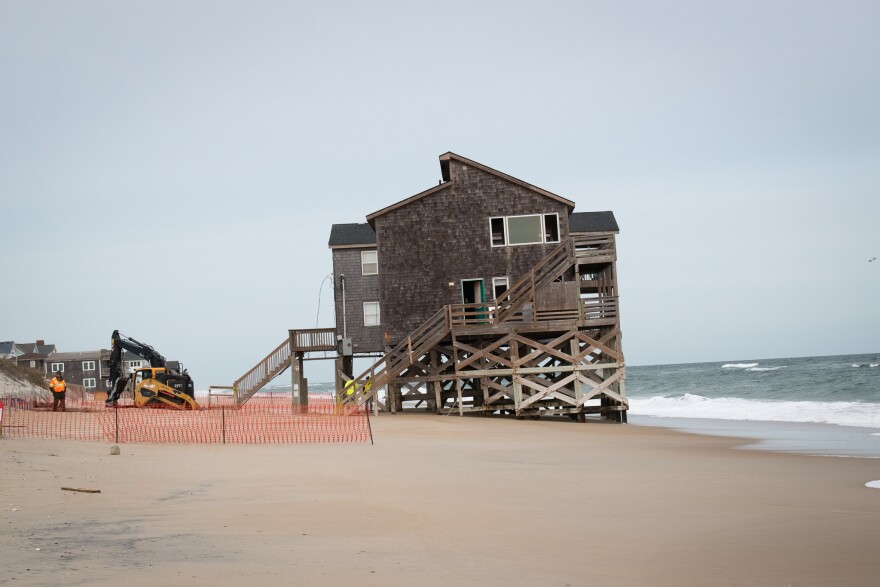Rodanthe has captured the popular imagination for two things in recent years: the “Nights in Rodanthe” house and oceanfront real estate collapsing into the sea.
Last Wednesday, the National Park Service took the next step in a pilot mitigation program aimed at removing threatened oceanfront structures, or homes seaward of the dune and vegetation line. The park service tapped the Land and Water Conservation Fund to purchase two homes in September.
“Those funds for land acquisition do not come from taxpayer dollars,” said Dave Hallac, superintendent of the Cape Hatteras National Seashore. “They're generated through earnings from offshore oil and gas leasing.”
Deconstruction began just hours from low tide. Waves still lapped at the easternmost pilings of 23292 East Beacon Rd., or “Mermaid’s Kiss,” as the previous owner called it. The “Nights in Rodanthe” home peeks over a dune separating the two stranded buildings from the road. They used to be neighbors.
When houses fall, it creates a mess
Five Rodanthe homes have fallen into the sea since 2020.
“Sometimes the homes have even fallen when the waves are calmer,” said Alyson Flynn, an environmental economist for the Coastal Federation, a nonprofit that advocates for protecting and restoring the North Carolina coast. “Even then, the debris field has spread miles.”
Debris from one home traveled 21 miles down the coast. Homeowners often leave behind furniture and other belongings to claim the maximum insurance payout. Materials from the home mix with toxic liquids from HVAC units and refrigerators once the homes crumble.
“You name it,” said Flynn, “You could probably find it out there on the beach after one of these houses falls.”

The National Park Service estimates that there are “another dozen” threatened homes in Rodanthe. Flynn remembers that when a home collapsed on Ocean Drive in February last year, there was a “distinct smell of septic waste along the beach.” Two more homes on this same street fell three months later.
The North Carolina Coastal Resources Commission proposed a rule this year that would require homeowners to obtain permits for the replacement or relocation of a septic system belonging to one of these threatened homes.
Lack of accountability with oceanfront properties
The situation is strange. Because these houses are situated in the middle of a public beach, anyone can suddenly find themselves wandering through what used to be a neighborhood. Children cast fishing lines off balconies. Renters hang hammocks between the pilings as the surf washes under their feet.


For locals, their relationship with these properties is complicated.
Elaine Hooper manages the Hatteras Island Pet Resort across the street from the two properties the park service purchased.
On one hand, she said, coastal erosion has always been an issue in Rodanthe. Her family has lived on Hatteras Island since the 1700s.
“This should not be news to anybody,” said Hooper. “The island is moving. That is its job.”
On the other hand, Hooper said sellers could be more transparent about these homes’ histories in their listings.
“The seller should have to disclose if they know there used to be another row of houses,” Hooper said. “Or if erosion has had a major impact on this house.”
The NC Coastal Resources Commission proposed a rule amendment this year to make disclosing flood information mandatory for sellers.
“No one agency can wait for someone else to fix the problem,” said Julie Youngman, a senior attorney at the Southern Environmental Law Center.
The Center wrote letters to the National Park Service and the North Carolina Department of Health and Human Services on behalf of the Coastal Federation in May.
The letter encouraged “both government agencies to use any and all authorities available to them to address the situation at Cape Hatteras with the falling houses,” according to Youngman.
The Southern Environmental Law Center argued that the National Park Service should leverage common law claims to hold homeowners accountable, including trespass and nuisance laws, and federal regulations surrounding improper refuse disposal and abandoned property.
When asked if the National Park Service was considering such action, Hallac said the Park Service was focused more on the carrot and less on the stick.
“We'll have to see how much progress we make over the coming years,” said Hallac, “ensuring that we can really minimize the impact to the resources of the seashore and public safety.”
Other interested homeowners have already contacted the park service about similar buyouts. The park service anticipates the full removal of both structures by early December barring inclement weather.







